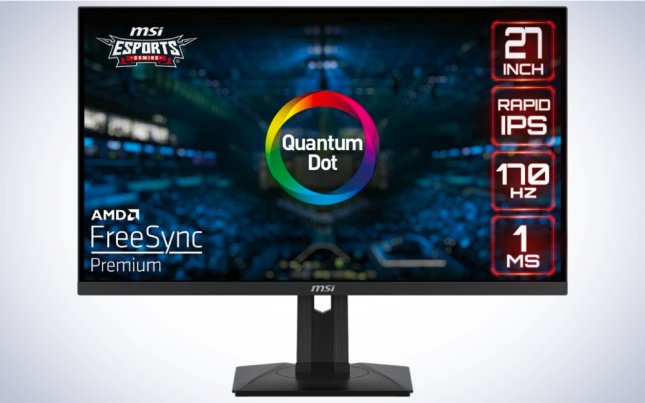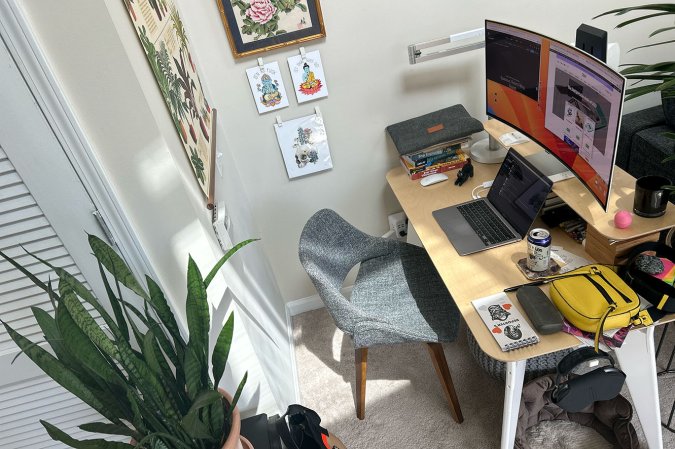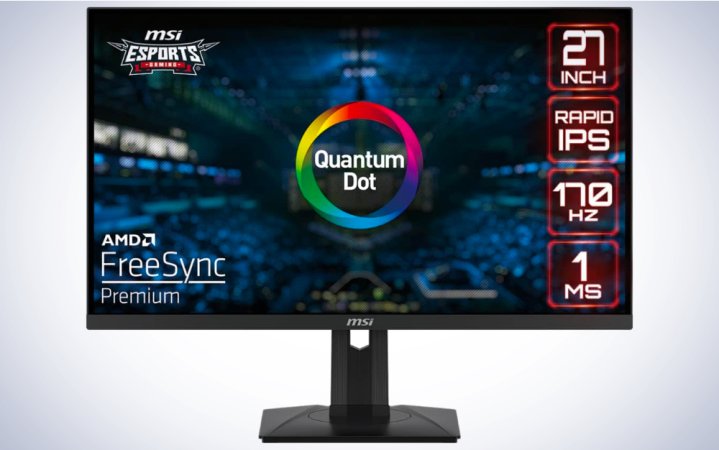We may earn revenue from the products available on this page and participate in affiliate programs. Learn more ›

High dynamic range (HDR) technology has become a standard feature in TVs, offering viewers a more immersive and lifelike viewing experience. Although less prevalent in monitors, HDR is steadily gaining traction on desks, particularly among gamers seeking the highest visual fidelity possible. However, HDR isn’t just for gamers; it’s equally fantastic for watching movies and editing photos and videos. Whether you’re indulging in Christopher Nolan’s Oppenheimer or diving into the latest AAA title, HDR technology enhances every frame with richer colors, deeper contrasts, and enhanced brightness, ensuring that every detail is displayed with stunning clarity and realism. For an unparalleled visual experience, the best HDR monitors will elevate gaming sessions and movie nights to new heights.
- Best overall: Dell Alienware 32 QD-OLED AW3225QF
- Best gaming: ViewSonic Elite XG320U
- Best ultrawide: Samsung Odyssey OLED G8
- Best splurge: Apple Pro Display XDR
- Best budget: MSI Optix G274QPF-QD
How we chose the best HDR monitors
We’re entering a new age of monitors, led by the prevalence of OLED technology and advancements in HDR quality. To curate this list, we conducted thorough industry research, tapped into expert insights from previous Popular Science coverage, and established stringent criteria to identify the best HDR monitors available. We hewed toward high-end models that offer higher peak brightness, full array local dimming (FALD), and a wider color gamut. However, we know that there is a wide range of budgets, so our recommendations factored in cost. The good news is the best HDR monitors will greatly enhance your experience, no matter your budget.
The best HDR monitors: Reviews & Recommendations
Once you see what HDR can do, you’ll never want to go without it. But, as we said, finding the right HDR monitor requires careful consideration of factors such as peak brightness, color accuracy, and compatibility with HDR formats. It’s essential to assess your specific usage scenarios and priorities, whether professional content creation, gaming, or casual entertainment.
Best overall: Dell Alienware 32 QD-OLED AW3225QF
Specs
- HDR: Dolby Vision and VESA DisplayHDR True Black 400
- Size: 32 inches
- Display: QD-OLED
- Resolution: 3,840 x 2,160
- Peak brightness: 1,000 nits
- Color: DCI-P3 99%
- Ports: DisplayPort 1.4, 2 x HDMI 2.1, 3 x USB-A (3.2 Gen 1), USB-B (3.2 Gen 1), USB-C (3.2 Gen 1)
- Price: $1,199.99
Pros
- High peak brightness
- High-resolution 4K display
- Wide color gamut
Cons
- No built-in speakers
With a 4K QD-OLED display, a peak brightness of 1,000 nits, and Dolby Vision support, the Dell Alienware 32 QD-OLED AW3225QF is the best overall HDR monitor available. As many television owners know, OLED technology and HDR go together like peanut butter and jelly, creating a synergy that delivers a perfectly complementary experience. The two technologies combine to offer perfect blacks and a wider color range, so even the subtlest details in HDR content become visible.
The Dell Alienware 32 QD-OLED AW3225QF debuted earlier this year, so it’s new to the market. It’s part of a wave of more advanced gaming monitors, with specs that include a 240Hz refresh rate, variable refresh rate, auto low-latency mode, G-Sync, and the aforementioned Dolby Vision. The monitor also features VESA DisplayHDR True Black 400, a certification standard specifically designed for OLED technology.
The monitor has a response time of 0.03ms to minimize motion blur and ensure smoother animations. Other specs include plenty of video and USB ports, including three USB-A (3.2 Gen 1), two HDMI 2.1 (one featuring eARC), and a USB-C (3.2 Gen 1). Unfortunately, there are no built-in speakers, so you’ll either need headphones, a compact soundbar, or desktop-friendly powered speakers for your setup.
Best gaming: ViewSonic Elite XG320U
Specs
- HDR: VESA DisplayHDR 600
- Size: 32 inches
- Display: IPS
- Resolution: 3,840 x 2,160
- Peak brightness: 600 nits
- Color: 99% Adobe RGB
- Ports: DisplayPort, HDMI 2.0, HDMI 2.1, 2 x USB-A, USB-C, micro USB
- Price: $899.99
Pros
- Beautiful display
- Accurate colors out of the box
- Supports tilt, swivel, and height adjustments
Cons
- – No USB-C
The ViewSonic Elite XG320U was our top overall pick among the best 4K gaming monitors, so it’s no surprise it’s showing up in another list. The monitor produces excellent colors right out of the box, and features VESA DisplayHDR 600. The 32-inch 4K display has a 150Hz refresh rate and supports AMD’s FreeSync variable refresh rate, allowing you to get smooth animations.
We also like the monitor because it offers numerous ports, including DisplayPort, HDMI 2.0, and HDMI 2.1. The latter port is critical for 4K gaming at 120Hz, allowing you to hook up an Xbox Series X, Series S, or PlayStation 5. The video ports are complemented by USB-A and USB-B ports to connect your various peripherals. Unfortunately, there is no USB-C connection. Other highlights include the monitor’s approach to thoughtful ergonomics, supporting tilt, swivel, and height adjustment.
Best ultrawide: Samsung Odyssey OLED G8
Specs
- HDR: HDR10+, VESA DisplayHDR True Black 400
- Size: 34 inches
- Display: QD-OLED
- Resolution: 3,440 x 1,440
- Peak brightness: 600 nits
- Color: 99% DCI-P3
- Ports: Mini DisplayPort, Micro-HDMI 2.1, 2 x USB-C
- Price: $1,099
Pros
- Beautiful ultrawide display
- Sleek, luxurious design
- Excellent image quality with rich colors and deep blacks
Cons
- Text clarity could be better
The Samsung Odyssey OLED G8 is another model that appeared in a previous guide. It’s a fantastic ultrawide monitor featuring a gorgeous QD-OLED display with a resolution of 3,440 x 1,440. While the 21:9 aspect ratio is unconventional, Tony Ware, the PopSci Editor, Commerce & Gear, says the extra real estate is great for productivity. He feels using the Odyssey OLED G8 (shown above in a work nook) feels like being at the helm of the Starship Enterprise.
The monitor delivers rich colors and true blacks, and the 175Hz refresh rate results in smooth animation. While the Odyssey G8 is a favorite among our editors, it’s worth mentioning that Samsung recently unveiled the Odyssey OLED G9 (G95SD) at the 2024 Consumer Electronics Show. The monitor has a 49-inch, 240Hz, 5,120 x 1,440 curved display, giving you an even larger canvas and faster refresh rate. That said, the exact pricing and release date haven’t been revealed, so we’re sticking with the Odyssey G8 as our top choice for now.
Best splurge: Apple Pro Display XDR
Specs
- HDR: Extreme Dynamic Range (XDR)
- Size: 32 inches
- Display: IPS
- Resolution: 6,016 x 3,384
- Peak brightness: 1600 nits
- Color: P3 wide color gamut
- Ports: Thunderbolt 3, 3 x USB-C
- Price: $4,999
Pros
- Beautiful, vibrant colors
- XDR is very bright
- Very sharp
Cons
- Very expensive
It doesn’t get more premium than the Apple Pro Display XDR. Truthfully, it’s a monitor for only those flush with cash and a high-end Mac. (For those on more of a budget, check out Apple’s Studio Display or one of our other favorite monitors for Mac.) Still, it offers a 6K resolution display, fantastic HDR performance (or XDR, as Apple calls it), and one of the most beautiful designs on the market.
The display supports Apple’s True Tone technology, which can automatically adjust the color and intensity of the screen to match the ambient light, providing a more natural viewing experience. Meanwhile, the monitor supports Dolby Vision and a contrast ratio of 1,000,000:1, boasting exceptional color accuracy and dynamic range, surpassing the capabilities of standard HDR formats.
Best budget: MSI Optix G274QPF-QD
MSI Optix G274QPF-QD
Specs
- HDR: VESA DisplayHDR 400
- Size: 27 inches
- Display: IPS
- Resolution: 2,560 x 1,440
- Peak brightness: 400 nits
- Color: 93% Adobe RGB, 95% DCI-P3
- Ports: 2 x HDMI 2.0, DisplayPort 1.4, USB-C
- Price: $329.99
Pros
- G-Sync compatible
- USB-C port to charge modern devices
- Monitor is rotatable
Cons
- No HDMI 2.1
Finding a budget HDR monitor can be tricky because the quality of the HDR can be bad for a number of reasons. The MSI Optix G274QPF-QD is an exception. It’s an affordable 1440p display featuring an impressive Quantum Dot Rapid IPS panel with a 170Hz refresh rate. Most importantly, it supports VESA DisplayHDR 400, 93% Adobe RGB, and 95% DCI-P3.
Make no mistake, it’s an entry-level option, but if you’re on a budget, it punches above its weight by delivering decent performance in all categories. Its impressive color accuracy makes it an excellent choice for everything you might throw at it, including everyday computing, watching movies, and playing games. It also impresses with a lot of little touches, offering a clean design with a tiltable screen to get just the right angle.
What is HDR?
High dynamic range (HDR) is a display technology that allows for a wider range of colors, deeper contrast, and better representation of brightness. Imagine playing a game like Resident Evil Village, which uses dramatic lighting to set a tone. With HDR, a monitor can accurately show details in brighter and darker scenes while displaying rich, vibrant colors. In other words, it can show a scene how a developer meant it to be seen.
It’s important to note that not all HDR is created equal, as some HDR specifications are better than others (which we’ll get into). A good HDR experience generally comes in a monitor that offers a high overall peak brightness, high-quality local dimming, and support for a wide color gamut. For optimal HDR performance, it’s essential to opt for a display with a combination of these features.
What to consider when shopping for the best HDR monitors
The quality of HDR technology varies depending on several factors. You shouldn’t just buy the first HDR monitor you come across. You need to consider some things, such as the monitor’s panel type, peak brightness, and local dimming capabilities.
Peak brightness
Not all HDR monitors are created equal. While having an HDR specification is a step in the right direction, some displays fall short when it comes to delivering a truly impactful HDR experience. One key factor to consider is peak brightness, which directly influences how effectively bright highlights are rendered. Aim for a monitor with at least 600 nits of peak brightness to enjoy vibrant HDR visuals.
To ensure a certain level of quality and performance, look for models that adhere to the VESA DisplayHDR standard. The certification program assigns tiers based on various metrics like brightness, contrast, and color accuracy. While DisplayHDR 600 is a good starting point, higher tiers like 1000 and 1400 offer even better performance.
Full array local dimming
Become familiar with FALD, or full array local dimming. The technology significantly enhances contrast and black levels in LED monitors by dynamically adjusting the backlighting behind the screen. The more dimming zones a monitor has, the finer the control over brightness, resulting in more nuanced contrast transitions and a more immersive viewing experience.
However, FALD isn’t a perfect solution. It can sometimes cause blooming, where light from bright areas bleeds into darker ones. If you prioritize absolute perfect blacks and are willing to invest more, consider OLED panels, where each pixel can be controlled independently, delivering near-perfect black levels, high image contrast, and rich colors. So, if you watch a moody movie like David Fincher’s Seven, you’ll be able to see all the details in the shadows, providing a more immersive experience.
HDR type
Confusingly, there are a few different HDR formats.
HDR10 is the most basic and widely supported format, offering a decent peak brightness of 1,000 nits and 10-bit color depth. However, HDR10 uses static metadata, meaning the brightness and color information applied is the same for the entire video or image, leading to limited optimization for scenes with varying brightness levels.
HDR10+ and Dolby Vision employ dynamic metadata, allowing for scene-by-scene or even frame-by-frame optimization of brightness and color. The result is more lifelike visuals with deeper blacks, brighter highlights, and better contrast. These formats will provide the most immersive experience.
Creating even more confusion is the fact that the content needs to support these different formats to enjoy the benefits of HDR. Additionally, the device you’re using, whether it’s a PC or console, needs to support the chosen HDR format.
Wide color gamut
There are two common color standards in the monitor space: DCI-P3 and Adobe RGB. Digital Cinema Initiatives – Protocol 3, or DCI-P3, is a wide color gamut that covers a significant portion of the colors visible to the human eye and is often used in the film industry. Monitors supporting DCI-P3 can reproduce a wider range of colors, producing more vivid and realistic visuals. We recommend looking at models that offer a DCI-P3 of 90 percent, which means the monitors can display 90 percent of the colors within the DCI-P3 color space.
Meanwhile, Adobe RGB covers an even wider range of colors than DCI-P3. It’s more widely used by professional photographers, graphic designers, and printing because it ensures their work looks consistent across different devices. However, to truly enjoy the benefits of Adobe RGB, the monitor needs to be properly calibrated, which can be a difficult process to get right without the proper tools.
FAQs
When HDR is implemented correctly, the experience is absolutely worth it. But, as we explained, there are a lot of factors that need to come together to enjoy the benefits. If you primarily use your monitor for productivity tasks, such as browsing and sending email, you don’t need HDR. But if you play games and watch movies, then HDR can enhance your experience.
The easiest way to confirm if your monitor supports HDR is to check the manual or product page. You can also look in your monitor’s settings to see if there’s a menu dedicated to HDR. For both options, you might simply see keywords such as HDR, VESA DisplayHDR, Dolby Vision, or HDR10. Of course, a practical way to see if your monitor supports HDR is to play an HDR movie. Some streaming services like Netflix offer HDR content.
There are so many variables at play when it comes to the optimal brightness for HDR. For example, the amount of ambient light in your environment can impact how much you need to adjust the brightness for the most enjoyable experience. The right brightness level also depends on your personal preference. We recommend setting it to a comfortable level that preserves details in both bright and dark areas without straining your eyes.
Any of the monitors on this list should offer a decent bright level to experience the benefits of HDR. If you can, go check out these monitors in person to see if you like how the picture looks. Once you do get one, experiment with different brightness settings on your HDR display to find the level that provides the best balance of picture quality and viewing comfort.
Final thoughts on the best HDR monitors
- Best overall: Dell Alienware 32 QD-OLED AW3225QF
- Best gaming: ViewSonic Elite XG320U
- Best ultrawide: Samsung Odyssey OLED G8
- Best splurge: Apple Pro Display XDR
- Best budget: MSI Optix G274QPF-QD
The allure of HDR continues to get brighter in the monitor space. While our top-rated 4K TVs deliver a superior experience, recent advancements have made HDR monitors a serious contender for desktop users. Their smaller screen size translates to sharper HDR visuals, where the impact of increased brightness, contrast, and color pops even more. Additionally, response times and refresh rates have skyrocketed, leading to smoother, blur-free action in high-speed games and movies. So, if you prioritize a high-performance, compact display for your desk, an HDR monitor could be the perfect upgrade, offering an incredible visual experience.







